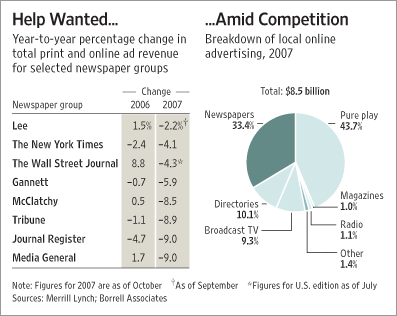
Local Papers' Web Scramble
Online Ads Migrate To Internet Players, Forcing New Steps
By Emily Steel
The Wall Street Journal
December 18, 2007
With Web companies now beginning to dominate the market for local ads online, newspaper publishers are scrambling to change the way they sell ads, hiring sales teams that specialize in the digital market and creating new editorial packages to sell. But it may be a case of too little, too late. McClatchy, which publishes 31 daily newspapers around the country, is revamping its commission and incentive plans to better reward staff for online sales. Gannett now operates 50 mom-centric social-networking sites around the U.S. as part of a broader strategy to boost online revenue through what it calls "hyper-localized" sites. Other publishers, from Lee Enterprises to Media General, are taking steps of their own to jump-start sales of local online ads.
But time may be running out. Now, for the first time, pure-play Web companies have the biggest share of the local online-ad market. In 2007, Internet companies had a 43.7% share of the $8.5 billion local online-ad market, while newspaper companies had a 33.4% share, according to the media research firm Borrell Associates. Just three years ago, newspapers had 44.1% of the local online-ad market. (Directories such as the Yellow Pages have 10.1%, and local television outlets 9.3%.)
Local media companies, because they are based in the communities they serve, would seem to have an edge over Internet sellers when it comes to persuading the diner or corner hardware store to take out an ad. But they have largely failed to convert that advantage into sales. Instead of tailoring their sales to local businesses, many newspaper companies initially focused on selling ads to bigger advertisers who were already buying space in their print products.
While this strategy allowed them to quickly and cheaply create a customer base for their online ventures, it also limited their growth, because they weren't expanding their customer base. Many newspapers also hurt themselves by simply plopping their papers online instead of creating new Web sites that offered advertisers something they couldn't get in print. Meanwhile, Web companies such as Google and Local.com are growing rapidly because they have made it cheap and easy for local companies to take out ads.
"Newspapers are tied too closely to defending their print products and have not seen the Internet as an innovative and competitive tool to go out and compete," says Gordon Borrell, chief executive of Borrell Associates.
Newspapers are feeling the biggest effects of this competition -- local TV outlets and directory businesses aren't experiencing the same degree of erosion in their core ad revenue. Analysts say newspapers may have maxed out on the amount of ads their existing print customers will buy online. They point to a slowing in the growth of online revenue across the newspaper industry. Online-ad revenues rose 21.1% in the third quarter to $773 million, down from 23% in the same quarter last year. The growth was as high as 39.7% in the first quarter of 2005. For newspapers, this slowing trend is taking place amid steep declines in the sales of print ads.
"All of the players, from Google to other local media companies, are putting more attention on going after the local dollar," says Jack Williams, president of Gannett Digital, the Gannett unit responsible for developing online revenue.
On the plus side for newspapers, there is still a huge potential opportunity: Spending for local online ads is expected to grow 48% next year to $12.6 billion.

On the flip side, newspapers have a massive challenge ahead: Online-ad revenue at newspapers made up only 7.1% of total revenue in the third quarter, according to the Newspaper Association of America. Analysts say that ideally that figure should be in the low double digits, then hit the midteens in about five years as the drop in print revenues stabilizes.
Increasingly, newspapers are deciding to form deeper alliances with their main competition. More than a year ago, Yahoo struck a deal with about a half-dozen newspapers to create a national online-ad sales network. Since then, additional newspapers have signed up. In the coming year, papers in the alliance will start using Yahoo technology on their sites so that they can sell more-sophisticated ad offerings, such as behaviorally targeted ads. Separately, a group of 11 newspaper companies representing nearly 300 newspapers recently formed a partnership with real-estate site Zillow.com to tap into more real-estate classified ads.
Analysts say these kinds of steps will help but that none is a silver bullet. "Ultimately, it is going to take a lot of singles to really have a significant impact on the overall operations of the company," says John Janedis, a publishing-industry analyst at Wachovia Securities.
Copyright 2007